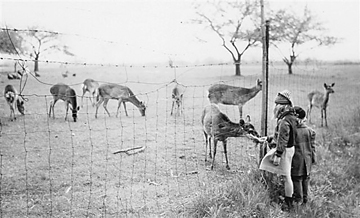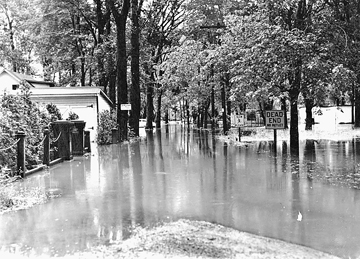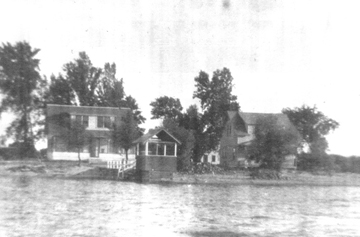Parma’s Lake Ontario Beaches
by David Crumb, Hilton Historian
Wright’s Beach
 Hilton Beach 1914. Margaret Fraser, Barbara Fraser, Alta Hicks, and Ruth Menter.What was known as Wright’s Beach is now known as the west end of Hilton Beach. Cottages were built between the First and Second Outlets where marsh waters drained back into the lake. Wright’s Beach was developed from the landholdings of George Albert Wright whose farm was located on the Huffer Road. The Wrights had been major land holders in the early days. George Albert’s father, George Wright Senior, owned a 60 acre farm on the Moul Road (Dick Barnes farm). His sister, Miranda Wright Wheeler, and her husband George Wheeler, owned a 114 acre farm adjacent and north on the Huffer Road which went all of the way to the lakeshore. Later, Miranda sold this farm to her nephew George, giving him a total of 168 acres. Around 1900, George Albert’s lakeshore frontage was sold off for cottages. According to his son, Fay, lots were sold for $50 each. In order to get to the cottages, residents had to access their property by way of a lane which led back through the fields to a small road on the high ground above the marshes. The reason being there were no bridges crossing the First and Second Outlets on Brush Creek.
Hilton Beach 1914. Margaret Fraser, Barbara Fraser, Alta Hicks, and Ruth Menter.What was known as Wright’s Beach is now known as the west end of Hilton Beach. Cottages were built between the First and Second Outlets where marsh waters drained back into the lake. Wright’s Beach was developed from the landholdings of George Albert Wright whose farm was located on the Huffer Road. The Wrights had been major land holders in the early days. George Albert’s father, George Wright Senior, owned a 60 acre farm on the Moul Road (Dick Barnes farm). His sister, Miranda Wright Wheeler, and her husband George Wheeler, owned a 114 acre farm adjacent and north on the Huffer Road which went all of the way to the lakeshore. Later, Miranda sold this farm to her nephew George, giving him a total of 168 acres. Around 1900, George Albert’s lakeshore frontage was sold off for cottages. According to his son, Fay, lots were sold for $50 each. In order to get to the cottages, residents had to access their property by way of a lane which led back through the fields to a small road on the high ground above the marshes. The reason being there were no bridges crossing the First and Second Outlets on Brush Creek.
 Mr. Ferguson’s small herd of Japanese Sitka deer which he fed and housed in a fenced-in field that had once been an apple orchard. The deer became tame and multiplied and were often visited by the summer residents. A tradition was to take corn husks from corn-on-the-cob and put them into a bag to feed the deer. When Mr. Ferguson died in 1957, Mrs. Ferguson, unable to care for the deer, donated them to Seneca Park Zoo. Shown, Lucille and Genie Schultz feeding the deer.The east part of West Hilton Beach was developed by Nicholas Arthur Schultz whose farm extended to the lakeshore. Mr. Schultz, his wife, Birdie, and mother Anna, had lived in New York City where they were prominent landowners. Mother Anna, worried about her son’s health, felt living in the country by Lake Ontario would be beneficial for his well being. Developing their lakeshore property was one of their first enterprises.
Mr. Ferguson’s small herd of Japanese Sitka deer which he fed and housed in a fenced-in field that had once been an apple orchard. The deer became tame and multiplied and were often visited by the summer residents. A tradition was to take corn husks from corn-on-the-cob and put them into a bag to feed the deer. When Mr. Ferguson died in 1957, Mrs. Ferguson, unable to care for the deer, donated them to Seneca Park Zoo. Shown, Lucille and Genie Schultz feeding the deer.The east part of West Hilton Beach was developed by Nicholas Arthur Schultz whose farm extended to the lakeshore. Mr. Schultz, his wife, Birdie, and mother Anna, had lived in New York City where they were prominent landowners. Mother Anna, worried about her son’s health, felt living in the country by Lake Ontario would be beneficial for his well being. Developing their lakeshore property was one of their first enterprises.
East Hilton Beach
 High water, East Hilton Beach, 1952, on the old road that passed closely behind the cottages.The lake frontage that was to become known as East Hilton Beach was part of the farm of George Wright Srs’ daughter, Emma Wright Ferguson, and her husband Erve. In 1911 Mrs. Ferguson sold several lots to Allan B. Fraser, a Hilton merchant Mr. Fraser hired Erve Ferguson to build 4 cottages on those lots. Subsequently, Mrs. Ferguson sold the rest of her frontage to other Hilton residents who would build similar cottages. Many of these cottages were held in the same families for years. The Ways, Crumbs, Clevelands, Barnetts, Collamers, Babcocks, Lees, Scofields, Swartzs, Coopers, Knowles, Vernies, Greenauers, Eires, Tennys, and Services spent many summers from the beginning until the 1970s enjoying the cool breezes, swimming, boating, picnicking and just having fun times at Hilton Beach.
High water, East Hilton Beach, 1952, on the old road that passed closely behind the cottages.The lake frontage that was to become known as East Hilton Beach was part of the farm of George Wright Srs’ daughter, Emma Wright Ferguson, and her husband Erve. In 1911 Mrs. Ferguson sold several lots to Allan B. Fraser, a Hilton merchant Mr. Fraser hired Erve Ferguson to build 4 cottages on those lots. Subsequently, Mrs. Ferguson sold the rest of her frontage to other Hilton residents who would build similar cottages. Many of these cottages were held in the same families for years. The Ways, Crumbs, Clevelands, Barnetts, Collamers, Babcocks, Lees, Scofields, Swartzs, Coopers, Knowles, Vernies, Greenauers, Eires, Tennys, and Services spent many summers from the beginning until the 1970s enjoying the cool breezes, swimming, boating, picnicking and just having fun times at Hilton Beach.
Today many of the cottages are still there, however, remodeled for year around living. Some are recognizable, but others have totally changed from their original composition. A few of the original families are still there.
Mr. and Mrs. Ferguson continued to live in their homestead at the corner of Ferguson Drive and Lake Avenue. At one time Mr. Ferguson had a gas pump in his front lawn where he sold gas to the cottagers, and a small grocery store once located on the east side of Lake Avenue was later moved across the street and converted into a log cabin cottage. This was for many years the year around home of Luther and Dorothy Burritt.
Old timers will remember Mr. Ferguson’s small herd of Japanese Sitka deer which he fed and housed in a fenced-in field that had once been an apple orchard. The deer became tame and multiplied and were often visited by the summer residents. A tradition was to take corn husks from corn-on-the-cob and put them into a bag to feed the deer. When Mr. Ferguson died in 1957, Mrs. Ferguson, unable to care for the deer, donated them to Seneca Park Zoo.
Another interesting landmark at Hilton Beach on the west side of Lake Avenue across from the Ferguson Homestead is the Old Hilton Pumping Station. This was the water works for the village of Hilton that was pumped from the lake to the water tower (100,000 gallon capacity) on South Hill in the village. The water works was begun in 1915 and finished in 1916. Erve Ferguson was the pumping station master, and he held the job until he died in 1957, a tenure of 41 years. At the end of Lake Avenue was the well known “Town Pier” which was well made from old railroad ties. Anyone could come down and use the town pier for sunning or swimming, and it was the scene of much fun and social activity where the “locals” and the “townies” would gather together.
At the end of Ferguson Drive on the east side were two very “posh” summer estates. One owned by the Potter and Mahoney families, complete with an elegant residence and an authentic rustic log cabin guest-house. The other was the Reed-Peck residence. Both of these properties had full time gardeners. Harry Dilger was the caretaker of the Potter property. He wore puttees, laced leather around his lower legs to protect himself from the brambles and snakes. He had once been a caretaker on one of the Rockefeller estates located on the Hudson River. The Potter property always looked well manicured and picture perfect.
 Hilton Beach was also the site of a baseball diamond where Hilton’s famous Hilton Peaches played on Sundays. There was a village ordinance that no baseball was to be played on Sundays. To counteract this, Charles Skinner Sr. and Arthur Schultz created a diamond just south of the pumping station where well attended ball games were played and enjoyed by many during the spring and summer months.
Hilton Beach was also the site of a baseball diamond where Hilton’s famous Hilton Peaches played on Sundays. There was a village ordinance that no baseball was to be played on Sundays. To counteract this, Charles Skinner Sr. and Arthur Schultz created a diamond just south of the pumping station where well attended ball games were played and enjoyed by many during the spring and summer months.
Another memorable Hilton Beach occasion was the year that Catherine Bodler’s boyfriend spent the summer with the family. He was an opera singer from Manhattan and he would go out to the 3rd sandbar about 10:00 at night when the lake was calm and everyone was settled in. He then would serenade Catherine with soft and beautiful music that carried across the water; everyone for a half mile either way could hear and enjoy his overtures.
On occasion in the 1930s beach residents talked of hearing gun shots out on the lake in the night. Speculation was that bootleggers were being tracked by the law. By the way, has anyone ever seen the Northern Lights from Lake Ontario’s shore? It’s an incredible spectacle to witness!



